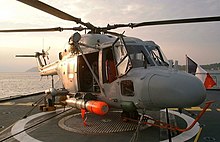| Mark 46 torpedo | |
|---|---|
 A Mk 46 exercise torpedo launched from USS Moosbrugger. | |
| Type | Lightweight anti-submarine torpedo[1] |
| Place of origin | United States |
| Service history | |
| In service | • Mod 0: 1963[1] • Mod 5: 1979 |
| Used by | See operators |
| Production history | |
| Designer | Naval Ordnance Test Station Pasadena[1] Aerojet[1] Alliant Techsystems |
| Designed | 1960[1] |
| Manufacturer | Aerojet[1] Naval Ordnance Station Forest Park Honeywell Raytheon[2] |
| Variants | Mod 0[1] Mod 1 Mod 2 Mod 5 Mod 5A Mod 5A(S) Mod 5A(SW)[2] |
| Specifications | |
| Mass | 508 lb (230 kg) |
| Length | 8 ft 6 in (2.59 m) |
| Diameter | 12.75 in (323.8 mm) |
| Warhead | PBXN-103 high explosive (bulk charge) |
| Warhead weight | 96.8 lb (43.9 kg) |
| Engine | Two-speed, reciprocating external combustion |
| Propellant | Otto fuel II |
Operational range | 12,000 yd (11,000 m) |
| Maximum depth | >1,200 ft (370 m) |
| Maximum speed | >40 kn (74 km/h; 46 mph) |
Guidance system | Active or passive/active acoustic homing |
Launch platform | Mark 32 Surface Vessel Torpedo Tubes, ASW Aircraft, RUM-139 VL-ASROC |



The Mark 46 torpedo is the backbone of the United States Navy's lightweight anti-submarine warfare torpedo inventory and is the NATO standard. These aerial torpedoes are designed to attack high-performance submarines. In 1989, an improvement program for the Mod 5 to the Mod 5A and Mod 5A(S) increased its shallow-water performance. The Mark 46 was initially developed as Research Torpedo Concept I (RETORC I), one of several weapons recommended for implementation by Project Nobska, a 1956 summer study on submarine warfare.[3]
- ^ a b c d e f g Jolie, E.W. (15 September 1978). "A Brief History of US Navy Torpedo Development: Torpedo Mk46". Retrieved 24 June 2013.
- ^ Friedman, Norman (1994). U.S. Submarines Since 1945: An Illustrated Design History. Annapolis, Maryland: Naval Institute Press. pp. 109-114. ISBN 1-55750-260-9.